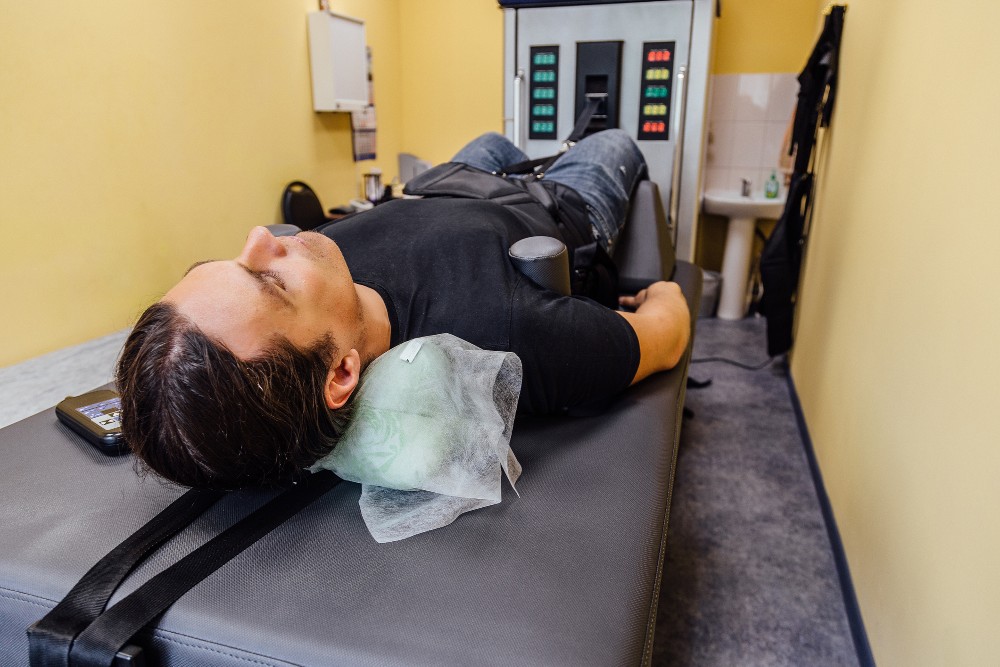Unlock Lasting Pain Relief with Laser Therapy and Chiropractic Care
There’s growing interest today in safe, non-invasive solutions for overcoming back pain and restoring a sense of normalcy. While prescription medications and surgery are common approaches to managing pain, they often come with significant drawbacks, including lengthy recovery times and unwanted side effects. As a result, many Oregonians are seeking out more natural, effective alternatives that support healing and long-term wellness.
At Total Body Chiropractic, our Bend chiropractors understand your concerns—and we’re here to help. That’s why we’re proud to offer laser therapy, a cutting-edge, effective treatment now available alongside our trusted and highly effective chiropractic care. This powerful, science-backed combination not only accelerates your healing and reduces pain but also expands our ability to treat a broader range of conditions than ever before.
Ready to hike Pilot Butte, play with your kids, enjoy sports, or work comfortably at your desk—without relying on painkillers? With the support of laser therapy combined with chiropractic care, it’s entirely possible. Let’s take a closer look at how this innovative therapy works and what you can expect when you visit your trusted chiropractor in Bend, Oregon.
What is Laser Therapy?
Let’s discuss what “laser therapy” means. You may have heard of it as Low-Level Laser Therapy (LLLT) or cold laser therapy. It uses the healing power of photons to help you self-heal. Surgical lasers usually cut or burn skin tissue; however, LLLT uses gentle, focused light energy to stimulate cellular activity in injured tissue beneath the skin. So, no heat, discomfort, damage, or scarring.
When you come for your laser therapy session in Bend, our chiropractors direct a specialized device over the injured area of your body. Penetrating deep into your tissues, this light energizes your cells to boost blood circulation and trigger a series of natural self-healing processes. That’s how LLLT accelerates tissue repair, reducing inflammation & providing immediate pain relief.
Treatment plans vary but most conditions can be treated with a few times a week to start. This method has been authenticated by many studies stating that LLLT has fewer side effects, is perfect for older patients, works like magic in pain management, helps your body heal faster, and provides quick pain relief. Our FDA-cleared laser device lets us treat a range of conditions, such as these:
- Soft tissue injuries, such as sprains and strains
- Joint pain in the knees, shoulders, wrists, or ankles
- Inflammation from overuse, repetitive motion, or acute trauma
- Tendonitis and bursitis, which often resist other treatments
Why Combine Laser Therapy and Chiropractic Care?

Did you know that 1,800 chiropractic physicians operate in the Beaver State? Annually, around 35 million Americans see a chiropractor. But our Bend chiropractors recommend combining the much-appreciated laser therapy with their usual methods due to “synergy.” It means that these treatment options complement each other’s therapeutic effects, helping you recover faster. With laser therapy, your tissues get ample light energy that reduces inflammation and calms your overactive nerves. As a result, your body becomes more receptive to chiropractic adjustments.
Our chiropractors can realign your spine and joints with greater precision and comfort, restoring healthy movement and function. They aim to ensure that your body’s overall structure supports optimal healing. When your spine and joints are moving in the right direction, you will see a 100% improvement in blood flow. That’s why research says that chiropractic care is an affordable, drug-free method for alleviating chronic pain. Using this laser-chiro combination, our Bend-based chiropractic team offer these benefits:
- Faster recovery from injury: Laser therapy accelerates tissue repair, while chiropractic care restores alignment. You heal quickly and thoroughly, so you can get back to your favorite activities.
- Reduced muscle tension and joint stress: The laser calms inflamed tissues, making spinal adjustments easier and more comfortable. You experience less soreness and faster relief.
- Improved mobility and long-term outcomes: By addressing both pain and underlying causes, you enjoy better movement and lasting results.
Our Bend chiropractors see these benefits daily. Athletes bounce back from sprains and strains. Parents find relief from chronic back or neck pain. Older adults manage arthritis-related joint pain and regain independence. Whether you are recovering from a recent injury or managing a long-standing condition, this combination offers a clear path to wellness.
What Conditions Are Best Treated Together?

At Total Body Chiropractic, we tailor every treatment plan to your unique needs and wellness goals. Using an amazing combo of laser therapy and chiropractic care, our experts in Bend can provide relief for range of conditions from chronic back pain to sports injuries:
Musculoskeletal Pain
For this kind of pain, a blend of laser therapy and chiropractic can prove quite beneficial.
- Back and Neck Pain: Studies show that blending laser therapy with chiropractic care is a wonderful treatment option for back pain. Laser therapy soothes your tense muscles and our expert chiropractors restore alignment. They can relieve nerve pressure and help you move freely again.
- Muscle Strains: Overworked muscles respond quickly to laser therapy. It boosts cellular repair and reduces swelling. With chiropractic adjustments, you can return to your daily routine with less risk of reinjury.
Joint Conditions
If you have a joint condition, this is what our laser-chiro treatment can do for you:
- Arthritis: Your daily life can become quite challenging with joint pain/stiffness. With laser therapy, your joints will become less inflamed and more mobile.
- Frozen Shoulder: This condition limits your shoulder’s movement and takes months to resolve. However, laser therapy reduces inflammation in the joint capsule, and chiropractic mobilizations restore movement.
Nerve-Related Issues
This process helps people experiencing these problems:
- Sciatica: This nerve pain radiates from your lower back, moving down your leg. It happens because of spinal misalignment or a herniated disc. So, this combo will calm your irritated nerves via inflammation reduction while relieving pressure on the sciatic nerve.
- Carpal Tunnel Syndrome: Nerve compression in your wrist can lead to a tingling feeling or numbness in your hand (or arm). Laser-chiro treats the inflammation and ensures that your wrist is aligning perfectly with your spine.
Post-Surgical Recovery or Injury Rehab
Your body takes time to heal after surgery. Laser energy quickens the tissue recovery process, reducing the formation of scars. Our chiropractors help restore routine movement patterns while preventing compensatory injuries. Together, these two therapies easily support a smoother, more complete recovery. That’s how you can get back to living fully.
No matter your condition, our Bend chiropractors will create a personalized plan to target your pain, speed your healing, and help you reclaim your active lifestyle.
Is It Safe? Does It Hurt? What Should I Expect?

Laser therapy is a safe, non-invasive, and drug-free treatment option for pain management and healing. Unlike traditional methods that may involve medications or surgery, deep tissue laser therapy has minimal side effects. It works by using low-level light that penetrates the skin without damaging surrounding tissues. The device used in our clinic is FDA-approved, and our chiropractors are professionally trained to administer the therapy with precision and care for targeted treatment.
Most patients report feeling nothing more than a gentle warmth during the session—if anything at all. There are no needles, no incisions, and no downtime. It’s a comfortable, relaxing experience that’s easy to fit into your day. You can even come in during your lunch break and head right back to your normal routine afterward.
During your visit to our Bend chiropractic clinic, we’ll begin by assessing your condition and determining the best treatment plan for your needs. A typical laser therapy session lasts just a few minutes, depending on the area being treated. The laser is applied directly to the skin over the affected area, where it gets to work stimulating cellular repair, reducing inflammation, and easing pain. While some people experience immediate relief, others notice improvement after a few sessions—especially when combined with chiropractic care.
How Often Should You Get These Treatments?
You’re probably wondering how often you should receive laser therapy treatment. The frequency largely depends on your individual goals and how your body responds to the therapy. For acute conditions—such as a recent sprain or strain—our chiropractors typically recommend starting with 2 to 3 sessions per week to effectively jumpstart your body’s natural healing process.
When it comes to chronic pain or long-standing issues, you might visit less often. Your sessions will then be spaced out over several weeks or even months. Our Bend chiropractor will create a highly personalized care plan based on your early assessment. Our goal is always to help you achieve lasting relief and independence, so you can return to your favorite activities as quickly and safely as possible.
Final Thoughts: Is Laser Therapy Right for You?
Are you tired of living with pain? Do you feel frustrated by slow progress with other treatments? The ideal solution is chiropractic laser therapy for a holistic, non-invasive path to healing. At Total Body Chiropractic, our Bend chiropractors help you unlock your body’s own natural ability to heal. We use the state-of-the-art Medray Quad Class IV laser technology and a personalized touch to deliver lasting results.
Ready to take the next step? Reach out to Total Body Chiropractic in Bend today. Schedule an appointment, ask questions, and discover how laser therapy & chiropractic care together can help you live pain-free. Your journey to lasting wellness starts now.



























